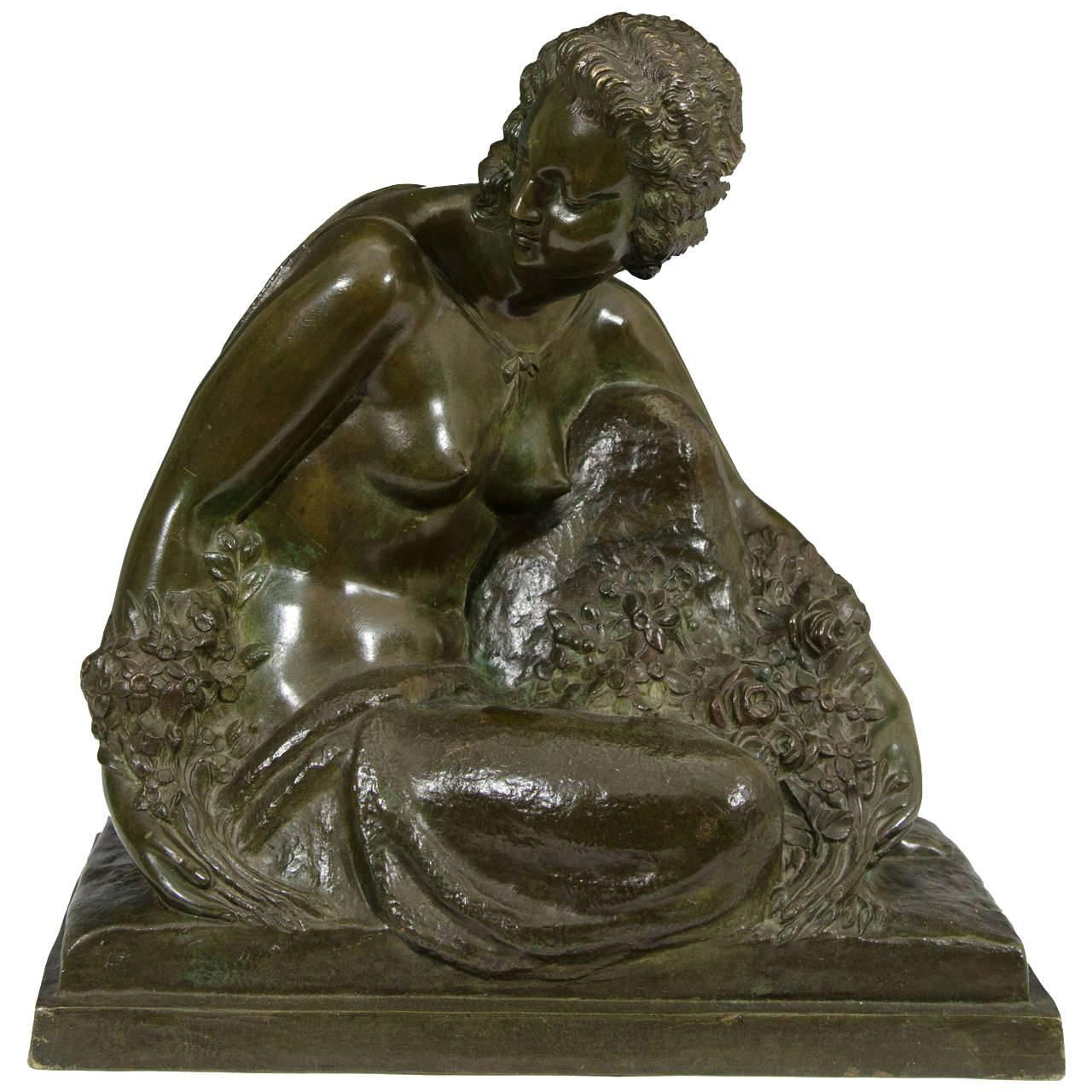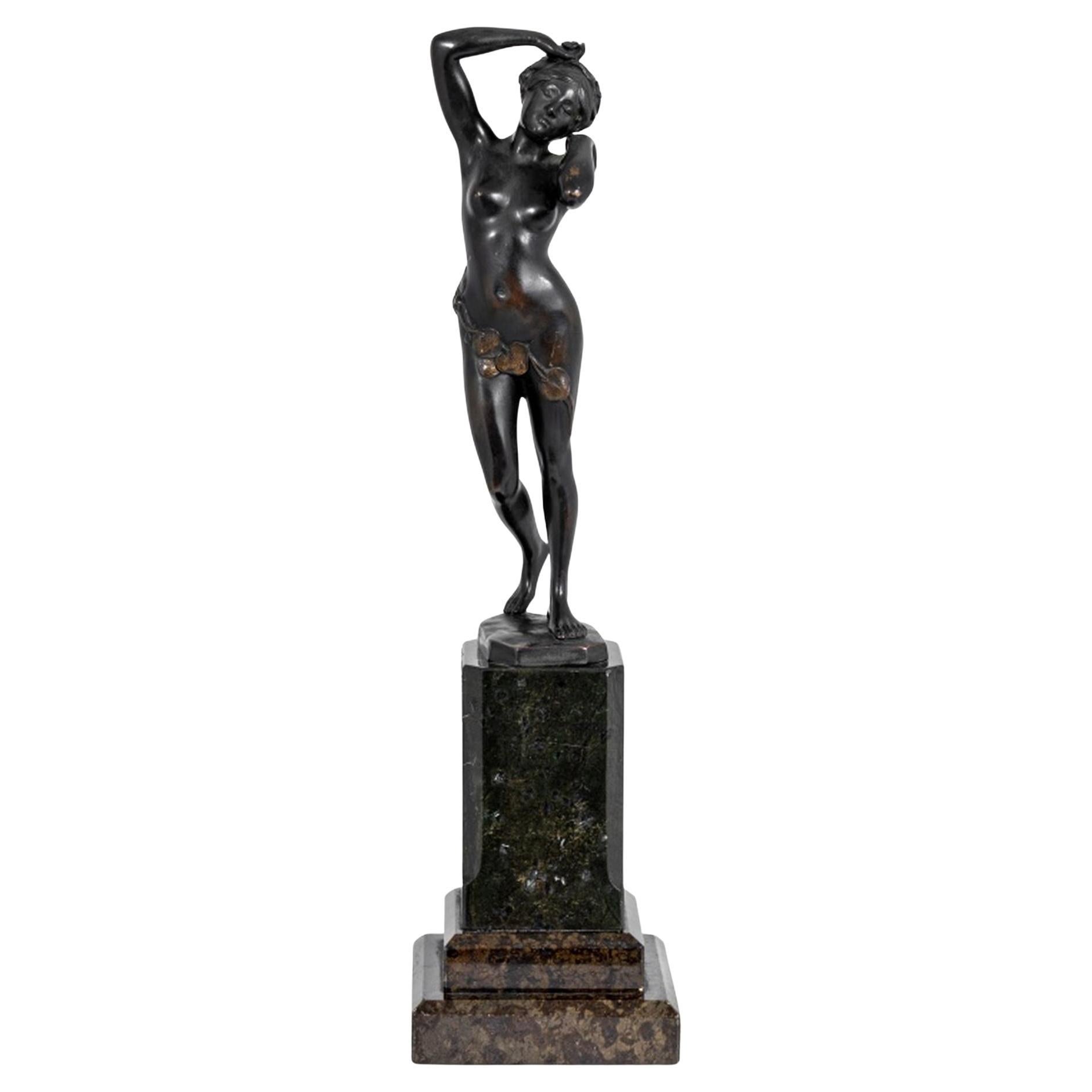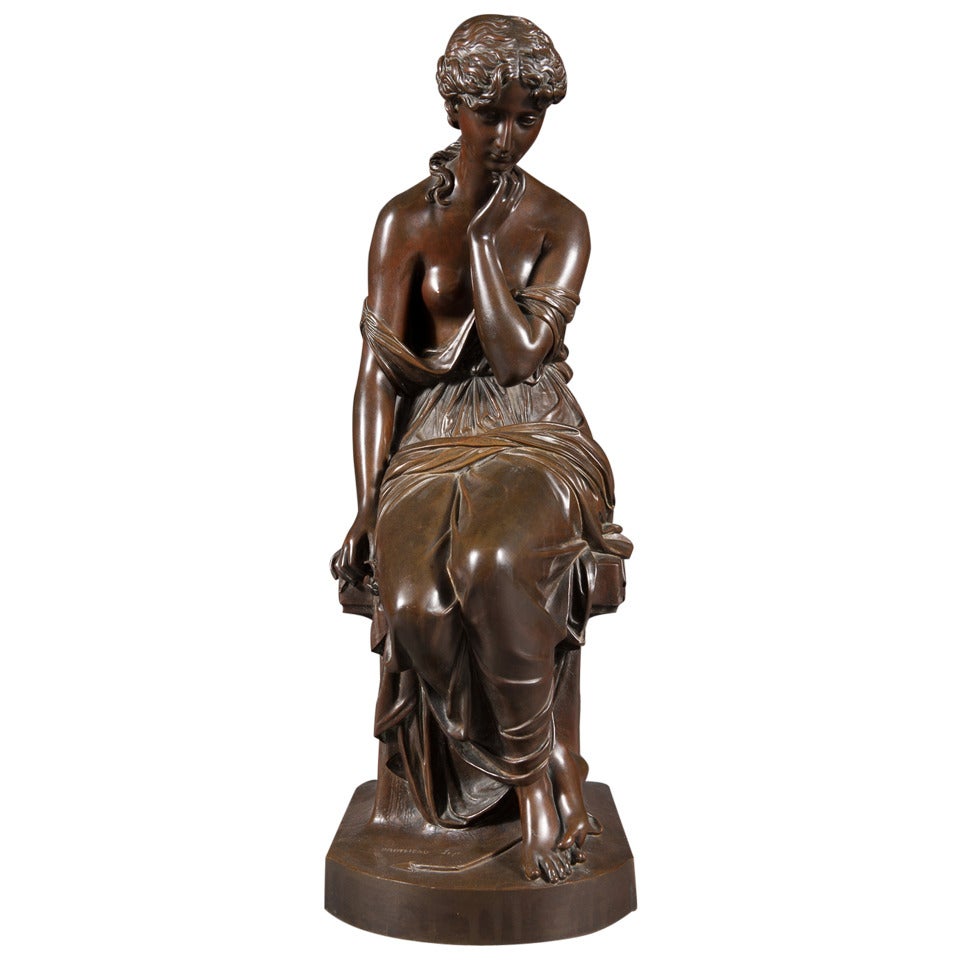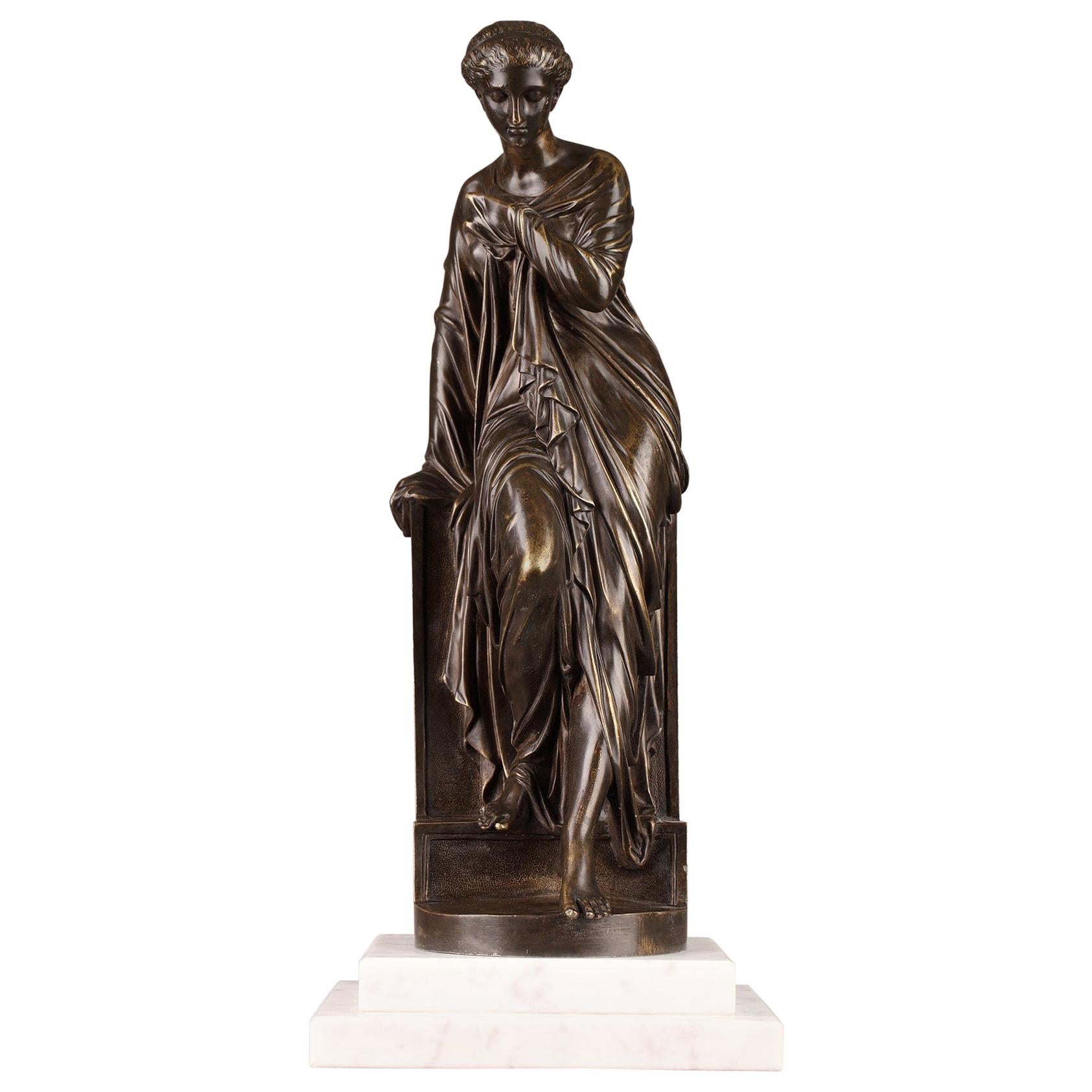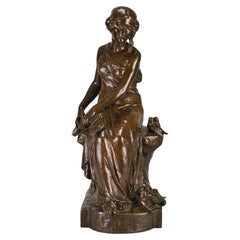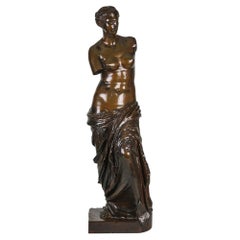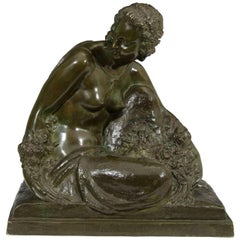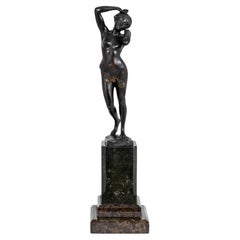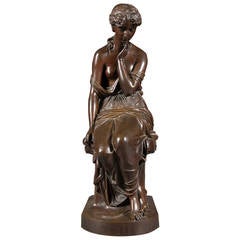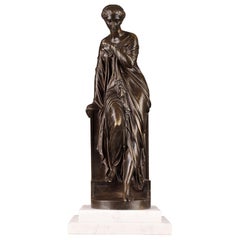Items Similar to Early 20th Century Patinated Bronze Entitled "Femme Allongée" by Gaston Béguin
Want more images or videos?
Request additional images or videos from the seller
1 of 13
Early 20th Century Patinated Bronze Entitled "Femme Allongée" by Gaston Béguin
$5,518.64
£4,000
€4,718.72
CA$7,590.80
A$8,437.65
CHF 4,422.83
MX$103,044.10
NOK 55,216.53
SEK 51,948.46
DKK 35,219.12
About the Item
An attractive early 20th century French Art Deco bronze figure of a resting beauty reclining on a daybed with a shawl delicately draped over her. The bronze exhibiting attractive deep green patination and very fine hand finished surface detail, raised on a black marble base and signed Béguin
ADDITIONAL INFORMATION
Height: 29 cm
Width: 46 cm
Condition: Excellent Original Condition
circa: 1920
Materials: Bronze
SKU: 8926
ABOUT
French Bronze
French Bronze During the 19th century a time when Paris was the centre of the art world, the French bronze sculptors and their foundries were creating work with remarkable precision and detail. Table-top and figurative bronzes became a popular feature of tasteful interior decor. Leading the demand of bronzes were foundries including: Barbedienne, Susse Freres, Peyrol and Siot-Decauville. The foundries became proficient at using both lost-wax and sand cast techniques to produce exceptional bronzes of outstanding quality.
- Creator:Gaston Béguin (Artist)
- Dimensions:Height: 11.42 in (29 cm)Width: 18.12 in (46 cm)Depth: 5.91 in (15 cm)
- Style:Art Deco (Of the Period)
- Materials and Techniques:
- Place of Origin:
- Period:
- Date of Manufacture:1920
- Condition:Wear consistent with age and use.
- Seller Location:London, GB
- Reference Number:Seller: 89261stDibs: LU3216334392412
About the Seller
5.0
Vetted Professional Seller
Every seller passes strict standards for authenticity and reliability
Established in 1936
1stDibs seller since 2017
84 sales on 1stDibs
Typical response time: <1 hour
- ShippingRetrieving quote...Shipping from: London, United Kingdom
- Return Policy
Authenticity Guarantee
In the unlikely event there’s an issue with an item’s authenticity, contact us within 1 year for a full refund. DetailsMoney-Back Guarantee
If your item is not as described, is damaged in transit, or does not arrive, contact us within 7 days for a full refund. Details24-Hour Cancellation
You have a 24-hour grace period in which to reconsider your purchase, with no questions asked.Vetted Professional Sellers
Our world-class sellers must adhere to strict standards for service and quality, maintaining the integrity of our listings.Price-Match Guarantee
If you find that a seller listed the same item for a lower price elsewhere, we’ll match it.Trusted Global Delivery
Our best-in-class carrier network provides specialized shipping options worldwide, including custom delivery.More From This Seller
View AllEarly 20th Century French Bronze Sculpture entitled "Delicate" by Paul Philippe
By Paul Philippe
Located in London, GB
An excellent French early 20th Century Art Deco bronze figure of a young attractive naked woman in an elegant pose with rich brown patination, raised on fitted green marble base & si...
Category
Early 20th Century French Art Deco Figurative Sculptures
Materials
Bronze
Late 19th Century Bronze Entitled 'La Verité Meconnue' by Aime-Jules Dalou
By Aimé-Jules Dalou
Located in London, GB
An enigmatic late 19th Century bronze study of a seated female nude leaning on her knees, hiding her face, on integral naturalistic canted rectangular base, signed to one side DALOU above the cracked mirror (facing to the rear), the opposing side marked Susse Fres Edts the rear with Susse Freres pastille flanked by the letters H P and S.
The title of this subject translates as 'The Truth Revealed' and refers to the young woman inconsolable having seen her true reflection in a mirror, which she has dropped and lies broken on the hard floor.
ADDITIONAL INFORMATION
Height: 14 cm
Width: 12 cm
Depth: 8 cm
Condition: Excellent Original Condition
Circa: 1890
Foundry: Susse Frères Paris
Materials: Bronze
SKU: 8790
ABOUT
Aimé-Jules Dalou...
Category
Antique 19th Century French Art Nouveau Figurative Sculptures
Materials
Bronze
Late 19th Century Bronze Sculpture entitled Femme avec Oiseau by Maurice Bouval
By Maurice Bouval
Located in London, GB
A fabulous Art Nouveau bronze figure of a young beauty sat upon a rock surrounded by birds whilst holding a lute with excellent colour and very fine hand chased surface detail, raise...
Category
Antique 19th Century French Art Nouveau Figurative Sculptures
Materials
Bronze
Late 19th Century Art Nouveau Sculpture "Venus de Milo" by F. Barbedienne
By F. Barbedienne Foundry
Located in London, GB
A large and impressive late 19th Century bronze study of the famous Venus de Milo sculpture of antiquity with excellent rich brown patina and good hand finished surface detail, inscribed F.Barbedienne foundry
ADDITIONAL INFORMATION
Height: 95 cm
Width: 28 cm
Depth: 28 cm
Condition: Excellent Original Condition
Circa: 1890
Materials: Bronze
Foundry: F.Barbedienne
SKU: 7741
ABOUT
The Barbedienne Foundry is a famous 19th century bronze foundry, whose statues and art objects became rapidly very renowned. This bronze studio co-worked with other trades, and put his name to a great variety of works, such as furnishing in particular. Attending every World's Fair of its time, the Barbedienne Foundry was regularly awarded, notably at the World's Fair of 1855 where it was awarded the Great Medal of Honor.
A Parisian bronze maker and caster, Ferdinand Barbedienne (1810-1892) creates a firm in 1839 in collaboration with Achille Collas, the inventor of the mechanical method to obtain copies of sculptures at a smaller scale. With this groundbreaking proceed, they facilitated an unprecedented production. Under the “Collas et Barbedienne” name, they specialized in Antiquity copies and perfected new chemical methods for the color and patina finish of their bronzes. As a true Romantic, Ferdinand Barbedienne is committed to democratization of arts, he thus realizes numerous Antiquity copies and stimulates his contemporaries’ works broadcasting. A great deal of famous sculptures are hence cast by the Barbedienne Foundry. All his life, Barbedienne co-worked with the greatest artists, sculptors or designers of his time, such as Edouard Lievre, Ferdinand Levillain, Attarge, Aizelin, Barye or Fremiet.
Statues aside, he products a great deal of decorative artifacts, such as clocks, vases, mirrors, etc. Since 1855, Ferdinand Barbedienne collaborates with the famous decoration designer Louis-Constant Sévin (1821-1888). Joining the firm as a sculptor-designer, he stays loyal to it his life long, always finding more new designs for daily objects, which hence become true art works. Sevin’s creations, specialized in the “Neo-Greek” style, were particularly appreciated for antiquity reference in decorative arts, just like the great mirror preserved by the Orsay Museum. He also teams up with enamelers including Alfred Serre, and develops a set of “cloisonnés” enamels that made the headlines at the World's Fair of 1862 in London, which was the very beginning of the art of enamel’s return. In collaboration with Serre, Barbedienne realized between 1878 and 1889 the Monumental Clock in Renaissance style, decorated with enamels, which is preserved in the Paris City Hall.
Venus de Milo
Facts about Venus de Milo sculpture.
For much of the world, the mystery of the Venus de Milo lies in her missing arms. But there’s much more to this iconic statue than a couple of absent appendages.
1. Venus de Milo‘s title is a bit misleading.
It’s popularly believed that this Grecian statue depicts the Greek Goddess of love and beauty, who was often rendered half-naked. However, the Greeks would have called this deity Aphrodite. Nonetheless, the Roman-inspired Venus de Milo caught on.
2. She’s named in part for where she was discovered.
On April 8, 1820, a farmer named Yorgos Kentrotas came across the statue in pieces within the ruins of an ancient city on the island of Milos (formerly known as Melos).
3. Alexandros of Antioch is credited with her creation.
A sculptor of the Hellenistic period, Alexandros is believed to have carved this masterpiece between 130 and 100 BCE. The inscription on the plinth—the slab on which the statue rested—that identified him as Venus de Milo‘s creator was lost nearly 200 years ago.
4. She might not be Venus.
Some have suggested the sculpture is not Aphrodite/Venus, but Amphitrite, the sea goddess who was particularly adored on Milos. Still others have proposed she’s Victory, or perhaps a prostitute. With her arms long missing, would-be context clues have been lost for centuries. A spear could have meant one thing, a spool of thread another. If she held an apple—as some reports claim—it could mean she was Aphrodite, holding the award given to her by Paris before the Trojan War began. To this day, it’s a matter of passionate debate.
5. She became a gift to the King of France.
When Kentrotas called upon a French naval officer to help him unearth the spectacular sculpture, he began a chain of events that would eventually lead to the Marquis de Rivière presenting Venus de Milo to Louis XVIII. In turn, the ruler gave the statue to the Louvre, where it is on display to this very day.
6. The loss of her limbs is the fault of the French.
Kentrotas did find fragments of an arm and a hand when he uncovered the statue in the ruins, but as Venus de Milo was being reassembled, those arms were discarded for having a “rougher” appearance. Modern art historians believe that the variation of finish does not mean those arms did not belong to Venus, but both the arms and the original plinth have been lost since the piece moved to Paris in 1820.
7. The original plinth was ditched on purpose.
Sight unseen, early 19th century art historians decided the newly discovered Venus must have been the work of Greek artist Praxiteles, and publicized the work as such. This attribution would have placed the piece in the Classical period (5th through 4th centuries BCE), which was more respected artistically than the Hellenistic period. To save face and better promote Venus de Milo—even at the cost of misinforming the public—the plinth was removed before it was presented to the King.
8. Venus de Milo was meant to make up for a national embarrassment.
During his conquests, Napoleon Bonaparte had plundered one of the finest examples of Greek sculpture, Venus de’ Medici, from Italy. In 1815, the French government returned that beloved sculpture, but in 1820, France embraced the chance to fill the hole its absence left in the French culture and national pride. As such, Venus de Milo was promoted as being even greater than Venus de’ Medici upon her Louvre debut. The ploy worked, and the piece was met with almost universal praise from artists and critics.
9. Renoir was not impressed.
Perhaps the most famous of Venus de Milo‘s detractors, the celebrated Impressionist painter dismissed this delicate depiction of grace and female beauty as “a big gendarme.”
10. She went into hiding during World War II.
By the autumn of 1939, war threatened to descend on Paris, so Venus de Milo along with some other priceless pieces, such as Winged Victory of Samothrace and Michelangelo’s Slaves, were whisked away for safekeeping at various châteaux in the French countryside.
11. She’s been robbed!
Venus is missing more than just her arms. She was originally draped in jewellery including a bracelet, earrings and a headband. These flourishes are long lost, but the holes for fixing them to the piece remain in the marble, giving clues to the missing accessories.
12. She lost her colour.
While it’s easy for today’s art admirers to think of Greek statues as white, the marble was often painted in the style of polychromy. However, no trace of the original paint scheme remains on Venus de Milo today.
13. She’s taller than most people.
Even with her slight slouch, Venus de Milo stands at 6 feet 8 inches tall.
14. She could be a copy.
Art historians have noted that Venus de Milo bears a striking resemblance to Aphrodite of Capua, which is a Roman era copy of a possibly late 4th century BCE bronze Greek original. That would be at least 170 years before Alexandros carved his goddess, leading some to speculate that both statues are actually replicas of an older statue...
Category
Antique Late 19th Century French Art Nouveau Figurative Sculptures
Materials
Bronze
Late 19th Century Art Nouveau Bronze figure "Slave Girl" by Emmanuel Villanis
By Emmanuel Villanis
Located in London, GB
A beautiful patinated Art Nouveau bronze study of a young Art Nouveau beauty sat upon a wall wearing chains with excellent variegated rich brown patina and excellent hand chased surf...
Category
Antique Late 19th Century French Art Nouveau Figurative Sculptures
Materials
Bronze
Early 20th Century Sculpture Entitled "Été" by Demetre Chiparus
By Demetre Chiparus
Located in London, GB
A fabulous Art Deco cold painted gilt and silver bronze figure of a beautiful young woman reclining on a bed of wheat sheaves exhibiting rich colour and very fine hand chased surface...
Category
Early 20th Century French Art Deco Figurative Sculptures
Materials
Bronze
You May Also Like
Marcel-André Bouraine, Nude, French Art Deco Bronze Sculpture, circa 1920s
By Marcel-André Bouraine
Located in New York, NY
An Art Deco bronze sculpture of a seated semi-nude woman by Marcel-André Bouraine, French, 1886-1948.
Category
Vintage 1920s French Art Deco Figurative Sculptures
Materials
Bronze
$4,550 Sale Price
30% Off
Charles Masse Nude Woman Patinated Bronze
By Charles Masse
Located in Astoria, NY
Charles Masse (French, 1855-1913) Nude Woman Patinated Bronze Sculpture, late 19th century, the standing figure draped with Gingko leaves, on a green serpentine plinth, signed to bas...
Category
Antique Late 19th Century French Art Nouveau Figurative Sculptures
Materials
Serpentine, Bronze
19th Century French Patinated Bronze Figure of a Women with a Lillie
Located in Los Angeles, CA
Origin: France.
Period: 19th century.
Material: Bronze.
Category
20th Century French Sculptures
Materials
Bronze
Late 19th Century Bronze Statue, Suzanne by Eugene-Antoine Aizelin
By Eugene-Antoine Aizelin
Located in Paris, FR
Bronze statue in brown patina representing Susanna, sculpted by Eugene-Antoine Aizelin (1821-1902). Susanna at the bath is a story from the apocryphal ...
Category
Antique Late 19th Century French Neoclassical Figurative Sculptures
Materials
Carrara Marble, Bronze
Large Woman Sculpture Patinated Bronze by Johannes Hansen, Denmark, 1940s
By Johannes Hansen
Located in Odense, DK
Large cast bronze sculpture by Danish artist Johannes Hansen depicting a young girl lost in thoughts. The sculpture was made in the 1940s at the bronze foundry "L. Rasmussen" in Cope...
Category
Vintage 1940s Danish Scandinavian Modern Figurative Sculptures
Materials
Bronze
20th Century French Vintage Bronze Statuette of a Woman - Fonderies Gailly
Located in West Palm Beach, FL
A vintage French Art Deco style statuette of a seated woman made of hand crafted bronze, resting on a rectangular Tinos green marble base, in good condition. The base has an engravin...
Category
Mid-20th Century French Art Deco Figurative Sculptures
Materials
Metal, Bronze
More Ways To Browse
Early 20th Century Recliner
Gold Shawl
Green Recliner
Bronze Susse
Susse Freres Bronze
Paris Daybed
Art Deco Green Marble Table
Green Daybed
Antique France Shawls
Antique French Daybed
Reclining Marble Sculpture
Recliner Daybed
Reclining Daybed
Gaston Bronze
French Art Deco Daybed
Siot Paris
Gold Tree Trunk
Grand Tour Bronze Roman
